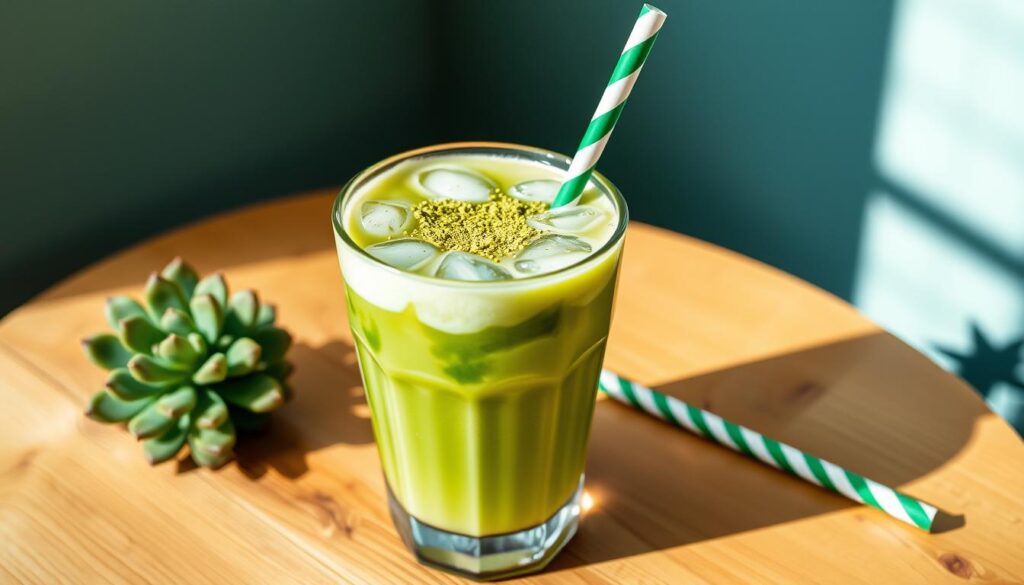Want a tasty café-style matcha drink without going out? Making a homemade iced matcha latte is simple. This green tea drink is a hit, offering a cool and healthy coffee alternative.
By making your own green tea latte, you can pick every detail. Choose the best matcha powder and your favorite milk. You’ll make a drink that’s just as good as any coffee shop’s.
Key Takeaways
- Learn to create professional-quality iced matcha latte at home
- Explore the versatility of matcha tea preparation
- Save money by making café-style drinks in your kitchen
- Customize your drink with various milk and sweetener options
- Discover the health benefits of matcha green tea
What is Matcha and Its Health Benefits
Matcha is a green tea powder from Japan, known for its wellness and nutrition benefits. It’s different from regular tea because of how it’s made and its health perks.
In Japan, matcha is made by grinding green tea leaves into a fine powder. Unlike other teas, you drink the whole leaf. This makes matcha rich in antioxidants and nutrients.
Antioxidant Powerhouse
Matcha is full of antioxidants called catechins. These help protect your body from harmful free radicals.
- Contains up to 137 times more antioxidants than regular green tea
- Supports cellular health and reduces inflammation
- Helps protect against chronic diseases
Energy-Boosting Properties
Matcha gives you a smooth energy boost without the jitters. It has L-theanine, which helps you stay calm and focused.
Nutritional Profile
| Nutrient | Amount per 1g |
|---|---|
| Calories | 3 |
| Protein | 0.3g |
| Fiber | 0.2g |
| Vitamin C | 1.5mg |
“Matcha is not just a beverage, it’s a lifestyle choice for health-conscious individuals.” – Japanese Tea Master
Choosing matcha means adding a nutrient-rich drink to your diet. It’s a natural way to boost your health every day.
Essential Ingredients for the Perfect Iced Matcha Latte
Making a great iced matcha latte begins with picking top-notch ingredients. The right mix can turn your home brew into a cafe-quality drink that pleases your senses.
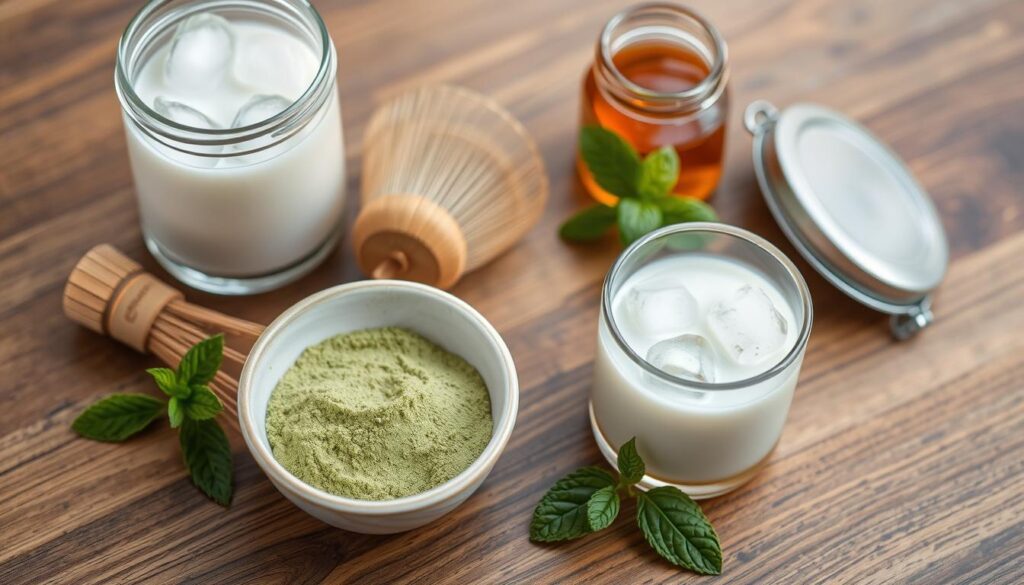
- Matcha Powder: The main ingredient that sets the drink’s taste and quality
- Milk: Key for a smooth, creamy feel
- Sweeteners: Optional but good for a balanced taste
- Ice: Needed for the cool “iced” feel
Choosing the best matcha powder is key. Look for bright green, finely ground powder with a strong scent. The quality of matcha powder greatly affects the latte’s taste and health benefits.
| Ingredient | Quality Indicators | Recommended Type |
|---|---|---|
| Matcha Powder | Bright green color, fine texture | Ceremonial grade |
| Milk for Matcha Latte | Smooth, creamy consistency | Whole milk or plant-based alternatives |
| Ice for Iced Matcha | Clean, filtered water | Large, clear ice cubes |
“The secret to an amazing iced matcha latte lies in the quality of your ingredients.”
When picking milk for your matcha latte, think about whole milk, almond milk, oat milk, or coconut milk. Each has a special flavor that can make your drink better.
Required Tools and Equipment
Making the perfect matcha latte at home needs special tools. These tools can change how you brew tea. Whether you love traditional tea or modern gadgets, the right gear makes a big difference.
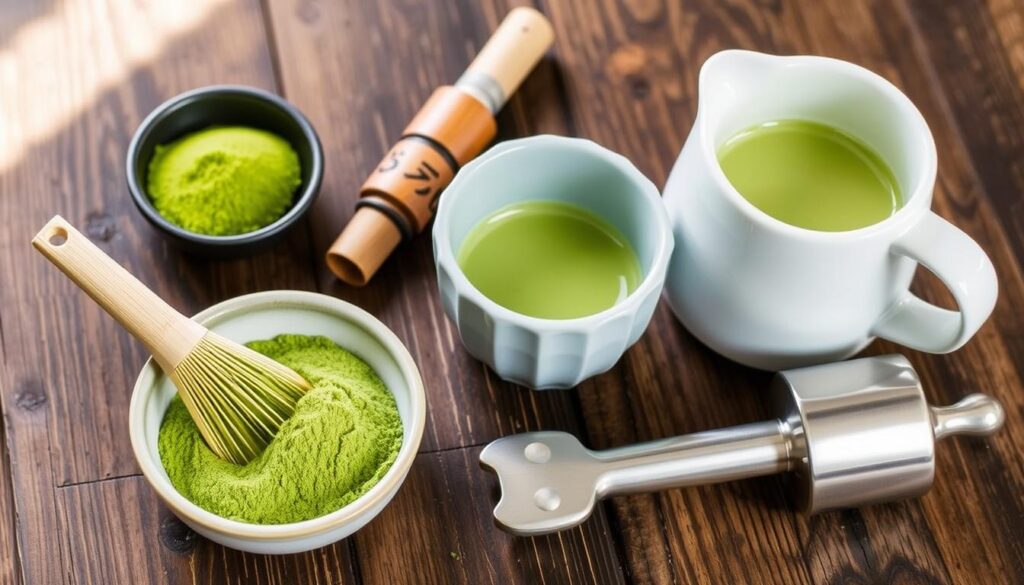
Matcha brewing is an art that mixes old traditions with today’s ease. Knowing the key tools helps you make a drink as good as a cafe’s.
Traditional Matcha Tools
Japanese matcha making uses special tools for the best taste and texture:
- Matcha whisk (chasen): A fine bamboo tool for mixing matcha powder smoothly
- Bamboo scoop (chashaku): A tool for exact matcha powder measurement
- Matcha bowl (chawan): A wide ceramic bowl for whisking and showing off the tea’s color
Modern Preparation Alternatives
For those who want it easy, modern tools are great:
| Traditional Tool | Modern Alternative |
|---|---|
| Bamboo Whisk | Electric frother |
| Bamboo Scoop | Measuring spoon |
| Ceramic Matcha Bowl | Regular mixing cup or blender |
Modern tools make brewing easier, but some say traditional tools give a better experience. An electric frother can mix matcha fast, but it might not make the same foam as a bamboo whisk.
“The right tools can elevate your matcha from good to exceptional.” – Tea Brewing Expert
Choose the tools that fit your lifestyle and how you like to brew.
How to Make a Café-Style Iced Matcha Latte at Home
Making a tasty homemade matcha drink is simple! This iced green tea latte recipe turns your kitchen into a café. You can make professional-quality drinks at home.
- Gather your ingredients:
- High-quality matcha powder
- Cold milk (dairy or plant-based)
- Ice cubes
- Optional sweetener
- Sift 1-2 teaspoons of matcha powder into a bowl
- Add a small amount of hot water (not boiling)
- Whisk vigorously in a W motion until smooth
- Fill a glass with ice
- Pour milk over ice
- Add whisked matcha
- Stir and enjoy!
“The secret to a perfect iced matcha latte is in the whisking technique and quality of matcha powder.”
Here are some tips for your homemade matcha drink:
- Use ceremonial grade matcha for best flavor
- Ensure water temperature is around 175°F
- Invest in a bamboo whisk for authentic texture
| Ingredient | Quantity | Purpose |
|---|---|---|
| Matcha Powder | 1-2 teaspoons | Base flavor |
| Cold Milk | 1 cup | Creamy texture |
| Ice | 1/2 cup | Chilling |
With practice, you’ll make a pro-style iced green tea latte at home!
Choosing the Right Grade of Matcha Powder
Making the perfect iced matcha latte begins with picking the right matcha powder. Not all matcha is the same. Knowing the differences can make your drink go from good to great.
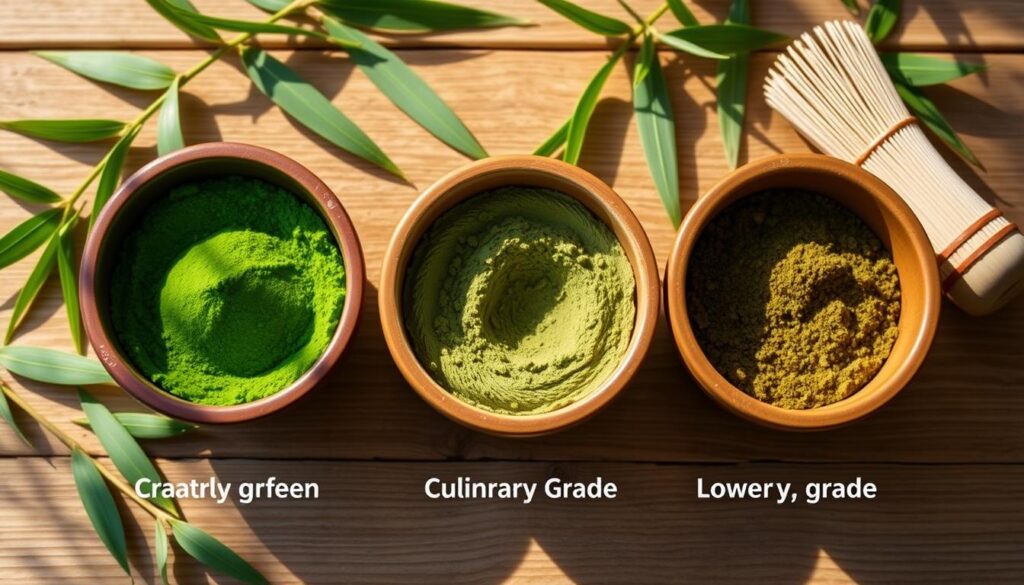
The quality of matcha powder is key to your drink’s taste and experience. The market mainly offers two types: ceremonial grade matcha and culinary grade matcha.
Ceremonial vs Culinary Grade Matcha
Ceremonial grade matcha is the top quality. It’s made from the youngest tea leaves. This grade has:
- Vibrant green color
- Smooth, delicate flavor
- Fine, silky texture
- Ideal for drinking straight
Culinary grade matcha is best for cooking and making drinks like your homemade iced latte. It has a stronger taste that works well with milk and sweeteners.
Storing Your Matcha for Maximum Freshness
Keeping your matcha fresh is important. Keep it away from light, heat, and moisture to keep its flavor and quality.
- Store in an opaque, airtight container
- Keep in a cool, dark place
- Refrigerate for longer storage
- Use within 1-2 months of opening
“The quality of your matcha directly impacts the taste of your latte. Choose wisely, store carefully.”
Milk Options and Their Impact on Taste
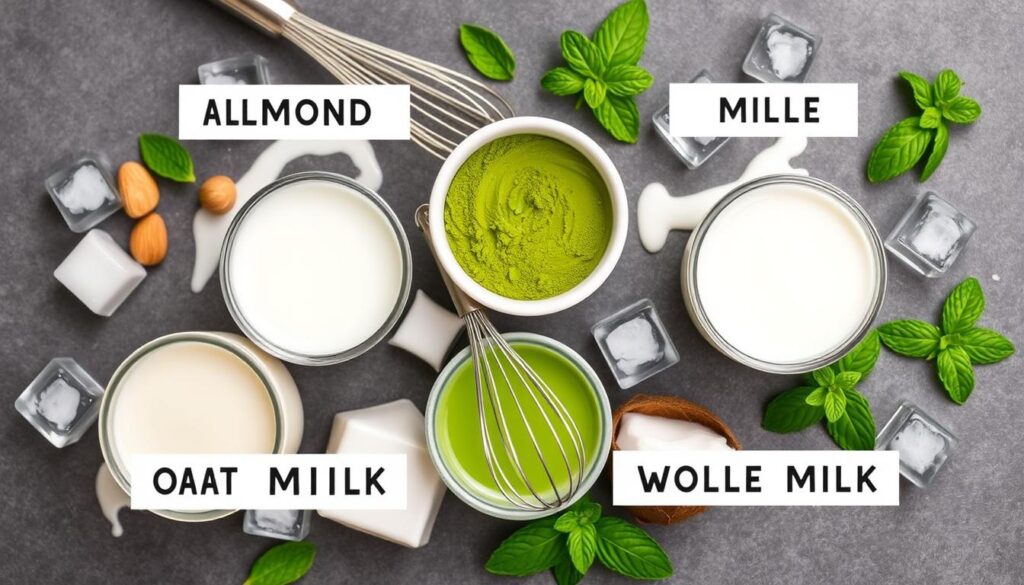
Choosing the right milk can make your matcha latte amazing. Different milks add unique flavors and textures. This makes picking the right one key to a perfect drink.
Whole milk is a top pick for matcha lovers. It’s creamy and rich, matching matcha’s earthy taste well. Whole milk makes your latte smooth and luxurious, like a fancy café treat.
- Whole Milk: Creamy and rich, ideal for traditional matcha lattes
- Skim Milk: Lighter option with less fat content
- Oat Milk: Trending plant-based milk alternative with a naturally sweet flavor
Plant-based milks have changed the matcha latte world. Oat milk is the top choice for non-dairy lovers. It’s smooth and sweet, mixing well with matcha’s complex taste.
“The right milk can elevate your matcha latte from a simple drink to a gourmet experience.” – Matcha Experts
If you want dairy-free, try these options:
- Almond milk – Light and nutty
- Coconut milk – Tropical undertones
- Soy milk – Protein-rich and creamy
Every milk adds its own twist to your matcha latte. Try different ones to find your favorite. Enjoy a drink that’s just right for you.
Tips for Achieving the Perfect Matcha Consistency
Creating a smooth and delicious matcha latte requires mastering specific matcha whisking techniques. The secret to a perfect drink lies in understanding how to prepare and blend your ingredients with precision.
Common Whisking Mistakes to Avoid
Achieving a smooth matcha texture can be challenging for beginners. Many people make critical errors that prevent them from creating the ideal matcha drink:
- Using water that is too hot, which can create bitter flavors
- Whisking inconsistently or too slowly
- Failing to break up matcha powder clumps before mixing
- Using low-quality or expired matcha powder
“The key to perfect matcha is patience and technique” – Japanese Tea Master
Temperature Considerations for Matcha Preparation
Matcha preparation tips emphasize the importance of water temperature. The ideal water temperature ranges between 160-180°F (70-80°C). Boiling water can destroy the delicate flavor profile and nutritional benefits of matcha.
- Let boiled water cool for 2-3 minutes before mixing
- Use a thermometer for precision
- Aim for lukewarm water to preserve matcha’s subtle taste
By focusing on these subtle details, you can transform your home matcha preparation from amateur to professional-level.
Sweetener Options and Measurements
Sweetening a matcha latte is all about finding the right balance. It’s about enhancing the flavor without overpowering the matcha. The right natural sweeteners can make your drink go from good to great.
Looking for sugar-free matcha options? Here are some great alternatives:
- Stevia: A zero-calorie plant-based sweetener perfect for sweetening matcha latte
- Monk fruit extract: Natural and low-glycemic
- Erythritol: A sugar alcohol with minimal impact on blood sugar
- Honey (in small quantities): Adds natural sweetness and complexity
“The key is to complement matcha’s earthy flavor, not mask it.” – Matcha Expert
Here are some tips for sweetening your matcha latte:
- Start with 1/2 teaspoon of sweetener
- Taste and gradually adjust
- Use liquid sweeteners for easier blending
For those looking for sugar-free matcha, trying different natural sweeteners is key. It helps you find the perfect balance without sacrificing health goals.
Creative Variations and Toppings
Make your homemade iced matcha latte special with fun matcha latte variations. These changes turn your drink into a tasty journey. Exploring different flavors lets you express yourself.
Adding unique iced matcha toppings makes your drink look and taste amazing. These extras not only boost the flavor but also make your drink perfect for Instagram.
Seasonal Flavor Inspirations
- Summer Tropical Twist: Coconut milk and fresh pineapple chunks
- Autumn Spice Blend: Pumpkin puree and cinnamon
- Winter Comfort: Vanilla bean and toasted marshmallow
- Spring Floral Notes: Lavender syrup and rose petals
Garnishing Ideas for Stunning Presentation
| Topping Category | Specific Suggestions |
|---|---|
| Fruit Garnishes | Strawberry slices, kiwi wheels, passion fruit seeds |
| Sweet Additions | Honey drizzle, maple crystals, caramel swirl |
| Textural Elements | Chia seeds, coconut flakes, edible flowers |
Pro tip: Experiment with different combinations to discover your signature iced matcha latte style!
“The art of a perfect matcha drink lies in fearless creativity and personal expression.” – Matcha Enthusiast
Troubleshooting Common Issues
Making the perfect iced matcha latte can be tough. Many people face problems that stop them from getting that café taste at home. Knowing these common issues can help you make a better, tastier drink.
Fixing Bitter Matcha Challenges
Bitter matcha can spoil your drink. The main reasons for bitterness are:
- Using low-quality matcha powder
- Whisking at incorrect water temperatures
- Overexposing matcha to hot water
To avoid bitterness, choose high-grade ceremonial matcha. Whisk it quickly with water around 175°F. Pro tip: Always sift your matcha before mixing to break up potential clumps.
Matcha Clumping Solutions
Matcha clumping is a common problem. Clumps make blending uneven and texture rough. Good solutions include:
- Use a fine mesh strainer to sift powder
- Invest in a bamboo whisk (chasen)
- Whisk in a zigzag motion, not circular
“Smooth matcha requires patience and technique” – Japanese Tea Masters
By using these tips, you can make your homemade iced matcha latte amazing.
Conclusion
Learning to make matcha is like turning your kitchen into a cozy café. This guide teaches you how to make tasty iced matcha lattes, just like a pro. Making your own matcha latte is not just about the taste. It’s also about saving money and making it just how you like it.
At home, you can try new things with iced matcha. Mix it with different milks, sweeteners, and toppings. Every try gets you closer to your ideal matcha drink. It’s a fun and rewarding journey.
Don’t worry if it takes time to get it right. Use the best matcha powder and learn the basics of whisking. Feel free to change things up to match your taste. Your matcha-making adventure is all about finding what works for you and enjoying the health perks.
Now you know how to make matcha lattes as good as those in cafes. Enjoy the learning, and relish every sip of your homemade matcha.
FAQ
What makes a café-style iced matcha latte different from a regular homemade version?
A café-style iced matcha latte uses top-notch ceremonial grade matcha. It also requires precise whisking and a professional touch. The result is a smoother texture, a vibrant green color, and a focus on the right mix of ingredients.
How long can I store prepared matcha powder?
Store matcha powder in an airtight container, away from light, heat, and moisture. It keeps well in the fridge for 1-2 months after opening. Always check for freshness and discard if the color or aroma changes.
Can I make a dairy-free iced matcha latte?
Yes, you can! Use plant-based milk alternatives like almond, oat, coconut, or soy milk. Each one adds a unique flavor that pairs well with matcha, depending on your taste.
Is matcha suitable for people watching their caffeine intake?
Matcha does contain caffeine, but it’s more balanced than coffee. A serving has about 25-35 mg of caffeine. This provides a gentle, sustained energy boost without the crash coffee can cause.
What’s the difference between ceremonial and culinary grade matcha?
Ceremonial grade matcha is the highest quality, perfect for tea ceremonies. It’s smoother and more delicate. Culinary grade matcha is more robust, great for cooking, baking, and drinks like lattes, with a slightly bitter taste.
How can I prevent my matcha from being lumpy?
To avoid clumps, sift your matcha powder before whisking. Use a bamboo whisk or a high-quality electric frother. Add liquid slowly while whisking in a W or M motion for a smooth texture.
Are there sugar-free options for sweetening my matcha latte?
Yes! Try natural sweeteners like stevia, monk fruit sweetener, or sugar-free syrups. They add sweetness without calories or affecting blood sugar.
How do I know if I’m using good quality matcha powder?
Good quality matcha powder is bright green, fine, and has a fresh, grassy smell. It should mix smoothly and have a balanced flavor without bitterness.
Share this post: on Twitter on Facebook

